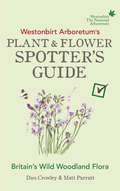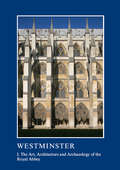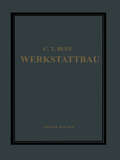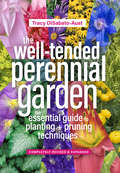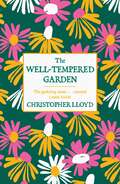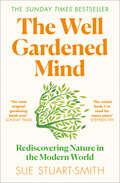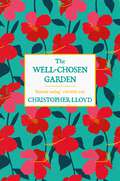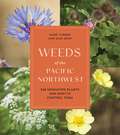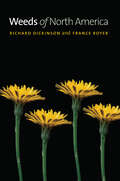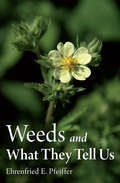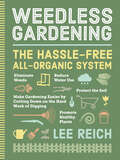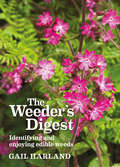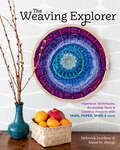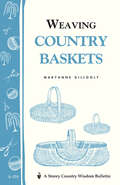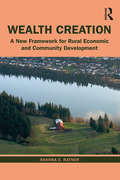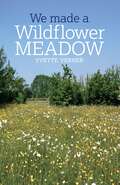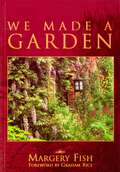- Table View
- List View
Westonbirt Arboretum’s Plant and Flower Spotter’s Guide
by Dan Crowley Matt ParrattGet back to nature with this easy to use guide to Britain's greenery. From the experts at Westonbirt Arboretum in the depths of the Cotswolds, with one of the most beautiful gardens in the world, comes this beautiful pocket guide covering 100 popular wild plants and flowers.Categorised by type of plant, the simple layout ensures that this text is easy to use ‘on the go’. Meadow Saffron, Sweet Woodruff and Solomon’s Seal are just a few examples of the vibrant entries - each accompanied by two beautiful images and a short description.Illustrated with enchanting colour artwork, depicting each plant and their individual bloom or sprig, this covetable book will educate and entertain with text by two leading experts from the Arboretum and the Forestry Commission.
Westminster Part I: The Art, Architecture and Archaeology of the Royal Abbey (The British Archaeological Association Conference Transactions)
by Warwick Rodwell Tim Tatton-BrownThe British Archaeological Association’s 2013 conference was devoted to the study of Westminster Abbey and the Palace of Westminster. It also embraced Westminster School, which was founded at the Reformation in the Abbey precinct. Collectively, these institutions occupy a remarkable assemblage of medieval and later buildings, most of which are well documented. Although the Association had held a conference at Westminster in 1902, this was the first time that the internationally important complex of historic buildings was examined holistically, and the papers published here cover a wide range of subject matter. Westminster came into existence in the later Anglo-Saxon period, and by the mid-11th century, when Edward the Confessor’s great new abbey was built, it was a major royal centre two miles south-west of the City of London. Within a century or so, it had become the principal seat of government in England, and this series of twenty-eight papers covers new research on the topography, buildings, art-history, architecture and archaeology of Westminster’s two great establishments — Abbey and Palace. Part I begins with studies of the topography of the area, an account of its Roman-period finds and an historiographical overview of the archaeology of the Abbey. Edward the Confessor’s enigmatic church plan is discussed and the evidence for later Romanesque structures is assembled for the first time. Five papers examine aspects of Henry III’s vast new Abbey church and its decoration. A further four cover aspects of the later medieval period, coronation, and Sir George Gilbert Scott’s impact as the Abbey’s greatest Surveyor of the Fabric. A pair of papers examines the development of the northern precinct of the Abbey, around St Margaret’s Church, and the remarkable buildings of Westminster School, created within the remains of the monastery in the 17th and 18th centuries. Part II part deals with the Palace of Westminster and its wider topography between the late 11th century and the devastating fire of 1834 that largely destroyed the medieval palace. William Rufus’s enormous hall and its famous roofs are completely reassessed, and comparisons discussed between this structure and the great hall at Caen. Other essays reconsider Henry III’s palace, St Stephen’s chapel, the king’s great chamber (the ‘Painted Chamber’) and the enigmatic Jewel Tower. The final papers examine the meeting places of Parliament and the living accommodation of the MPs who attended it, the topography of the Palace between the Reformation and the fire of 1834, and the building of the New Palace which is better known today as the Houses of Parliament.
Westminster Part I: The Art, Architecture and Archaeology of the Royal Abbey (The British Archaeological Association Conference Transactions)
by Warwick Rodwell; Tim Tatton-BrownThe British Archaeological Association’s 2013 conference was devoted to the study of Westminster Abbey and the Palace of Westminster. It also embraced Westminster School, which was founded at the Reformation in the Abbey precinct. Collectively, these institutions occupy a remarkable assemblage of medieval and later buildings, most of which are well documented. Although the Association had held a conference at Westminster in 1902, this was the first time that the internationally important complex of historic buildings was examined holistically, and the papers published here cover a wide range of subject matter. Westminster came into existence in the later Anglo-Saxon period, and by the mid-11th century, when Edward the Confessor’s great new abbey was built, it was a major royal centre two miles south-west of the City of London. Within a century or so, it had become the principal seat of government in England, and this series of twenty-eight papers covers new research on the topography, buildings, art-history, architecture and archaeology of Westminster’s two great establishments — Abbey and Palace. Part I begins with studies of the topography of the area, an account of its Roman-period finds and an historiographical overview of the archaeology of the Abbey. Edward the Confessor’s enigmatic church plan is discussed and the evidence for later Romanesque structures is assembled for the first time. Five papers examine aspects of Henry III’s vast new Abbey church and its decoration. A further four cover aspects of the later medieval period, coronation, and Sir George Gilbert Scott’s impact as the Abbey’s greatest Surveyor of the Fabric. A pair of papers examines the development of the northern precinct of the Abbey, around St Margaret’s Church, and the remarkable buildings of Westminster School, created within the remains of the monastery in the 17th and 18th centuries. Part II part deals with the Palace of Westminster and its wider topography between the late 11th century and the devastating fire of 1834 that largely destroyed the medieval palace. William Rufus’s enormous hall and its famous roofs are completely reassessed, and comparisons discussed between this structure and the great hall at Caen. Other essays reconsider Henry III’s palace, St Stephen’s chapel, the king’s great chamber (the ‘Painted Chamber’) and the enigmatic Jewel Tower. The final papers examine the meeting places of Parliament and the living accommodation of the MPs who attended it, the topography of the Palace between the Reformation and the fire of 1834, and the building of the New Palace which is better known today as the Houses of Parliament.
Werkstattbau: Anordnung, Gestaltung und Einrichtung von Werkanlagen Nach Massgabe der Betriebserfordernisse
by Carl Theodor BuffDieser Buchtitel ist Teil des Digitalisierungsprojekts Springer Book Archives mit Publikationen, die seit den Anfängen des Verlags von 1842 erschienen sind. Der Verlag stellt mit diesem Archiv Quellen für die historische wie auch die disziplingeschichtliche Forschung zur Verfügung, die jeweils im historischen Kontext betrachtet werden müssen. Dieser Titel erschien in der Zeit vor 1945 und wird daher in seiner zeittypischen politisch-ideologischen Ausrichtung vom Verlag nicht beworben.
Welwitschia (UEB contracted)
by RnibThis is an image, seen from the side, of a Welwitschia. It is a gymnosperm these are plants with cones, for example conifers. It is native only to the Nabib desert in Namibia and Angola and has no close relatives. There is a locator dot shown, which will be at the top left of the page when the image is the correct way up. The image has a dashed line image border.There is a cross section through desert soil stretching across the bottom quarter of the page.The plans roots branch out left and right through the soil from its very short woody stem in the bottom right of the page.Above this the image of the plant stretches across the bottom part of the page.It only has two twisted strap-like leaves throughout its life. They extend to the left and right from its stem. The leaf to the right extends beyond the image border. The leaves have two different textures (colours in Large Print). A lined texture (light green/brown) represents the top surface of the leaves and a fine dotted texture (dark green) the underside of the leaves. The twisted form of the leaves means that sections of both their top surfaces and the undersides can be found. These leave continue to grow throughout the plans life, becoming brown and frayed at their ends, and forming a tangled mass covering several square metres.The plant absorbs most of the water it needs through its leaves from the mists rolling in from the sea.The Welwitschia can live for more than 2000 years
Welwitschia (large print)
by RnibThis is an image, seen from the side, of a Welwitschia. It is a gymnosperm these are plants with cones, for example conifers. It is native only to the Nabib desert in Namibia and Angola and has no close relatives. There is a locator dot shown, which will be at the top left of the page when the image is the correct way up. The image has a dashed line image border.There is a cross section through desert soil stretching across the bottom quarter of the page.The plans roots branch out left and right through the soil from its very short woody stem in the bottom right of the page.Above this the image of the plant stretches across the bottom part of the page.It only has two twisted strap-like leaves throughout its life. They extend to the left and right from its stem. The leaf to the right extends beyond the image border. The leaves have two different textures (colours in Large Print). A lined texture (light green/brown) represents the top surface of the leaves and a fine dotted texture (dark green) the underside of the leaves. The twisted form of the leaves means that sections of both their top surfaces and the undersides can be found. These leave continue to grow throughout the plans life, becoming brown and frayed at their ends, and forming a tangled mass covering several square metres.The plant absorbs most of the water it needs through its leaves from the mists rolling in from the sea.The Welwitschia can live for more than 2000 years
The Well-Tended Perennial Garden: The Essential Guide to Planting and Pruning Techniques, Third Edition
by Tracy DiSabato-AustThis completely revised third edition of the bestselling classic The Well-Tended Perennial Garden is a must-have ally in the quest for a beautiful, well-maintained garden.
The Well-Tempered Garden: A New Edition Of The Gardening Classic (Horticulture Garden Classics Ser.)
by Christopher LloydA timeless gardening classic by Christopher Lloyd, one of Britain's most highly respected plantsmen, updated for the 21st century. With a new foreword by Anna Pavord.This is a classic work by a gardener who combines a passionate love of his subject with a critical intelligence and a good helping of wit. THE WELL-TEMPERED GARDEN is packed with the sort of information keen gardeners crave - from planting, weeding and the pleasures of propagation to annuals, water lilies and vegetables. Hailed as a masterpiece when it was first published, THE WELL-TEMPERED GARDEN is as fresh, enlightening and necessary for gardeners in the 21st century as it was when it first appeared more than 40 years ago.
The Well Gardened Mind: Rediscovering Nature In The Modern World
by Sue Stuart-Smith‘The wisest book I’ve read for many years … Much more than a gardening book, much more than a guide to mental health … Hugely recommended’ Stephen Fry
The Well-Chosen Garden
by Christopher LloydThe perfect book on how to make your garden the best it can be.'Essential reading' Country Life'Funny, encouraging, informative' Sunday TimesWould your garden, small or large, in town or country, win a prize? Is there room for improvement? Everybody has favourite plants, but the ability to put them all together to ensure a splendid show throughout the year is a skill that must be acquired. THE WELL-CHOSEN GARDEN will guide you to making the most of your available space, help you avoid untimely gaps, colour clashes and many other pitfalls of garden planning.The perfect book for new and experienced gardeners alike.
Weeds of the Pacific Northwest: 368 Unwanted Plants and How to Control Them
by Sami Gray Mark TurnerA comprehensive guide to the most common weeds of the Pacific Northwest, with essential information on their management and eradication Weeds are everywhere. They crowd out valuable agricultural crops, compete with the tomatoes and beans in your vegetable garden, spread rampantly along roadsides, and pop up from the tiniest cracks in sidewalks. In order to manage them, we must first learn how to identify them. Weeds of the Pacific Northwest is a guide to identifying, controlling, and eradicating over 300 species of weeds that gardeners and homeowners are likely to encounter in Northern California, Oregon, Washington, and British Columbia. Though they can all cause trouble, each weed is different. The hundreds of user-friendly photographs and detailed descriptions of each species here ensure that you can spot and treat any weed in your path. As the experts behind this book demonstrate, some plants can be killed by eating them, some by digging, some by smothering, and some only by the judicious application of chemical herbicides—and it is very important for you and your neighbors to know and understand the differences.
Weeds of North America
by Richard Dickinson France Royer“What is a weed,” opined Emerson, “but a plant whose virtues have not yet been discovered?” While that may be a worthy notion in theory, these plants of undiscovered virtue cause endless hours of toil for backyard gardeners. Wherever they take root, weeds compete for resources, and most often win. They also wreak havoc on industry—from agriculture to golf courses to civic landscape projects, vast amounts of money are spent to eradicate these virile and versatile invaders. With so much at stake, reliable information on weeds and their characteristics is crucial. Richard Dickinson and France Royer shed light on this complex world with Weeds of North America, the essential reference for all who wish to understand the science of the all-powerful weed. Encyclopedic in scope, the book is the first to cover North American weeds at every stage of growth. The book is organized by plant family, and more than five hundred species are featured. Each receives a two-page spread with images and text identification keys. Species are arranged within family alphabetically by scientific name, and entries include vital information on seed viability and germination requirements. Whether you believe, like Donald Culross Peattie, that “a weed is a plant out of place,” or align with Elizabeth Wheeler Wilcox’s “weeds are but unloved flowers,” Dickinson and Royer provide much-needed background on these intrusive organisms. In the battle with weeds, knowledge truly is power. Weeds of North America is the perfect tool for gardeners, as well as anyone working in the business of weed ecology and control.
Weeds of North America
by Richard Dickinson France Royer“What is a weed,” opined Emerson, “but a plant whose virtues have not yet been discovered?” While that may be a worthy notion in theory, these plants of undiscovered virtue cause endless hours of toil for backyard gardeners. Wherever they take root, weeds compete for resources, and most often win. They also wreak havoc on industry—from agriculture to golf courses to civic landscape projects, vast amounts of money are spent to eradicate these virile and versatile invaders. With so much at stake, reliable information on weeds and their characteristics is crucial. Richard Dickinson and France Royer shed light on this complex world with Weeds of North America, the essential reference for all who wish to understand the science of the all-powerful weed. Encyclopedic in scope, the book is the first to cover North American weeds at every stage of growth. The book is organized by plant family, and more than five hundred species are featured. Each receives a two-page spread with images and text identification keys. Species are arranged within family alphabetically by scientific name, and entries include vital information on seed viability and germination requirements. Whether you believe, like Donald Culross Peattie, that “a weed is a plant out of place,” or align with Elizabeth Wheeler Wilcox’s “weeds are but unloved flowers,” Dickinson and Royer provide much-needed background on these intrusive organisms. In the battle with weeds, knowledge truly is power. Weeds of North America is the perfect tool for gardeners, as well as anyone working in the business of weed ecology and control.
Weeds of North America
by Richard Dickinson France Royer“What is a weed,” opined Emerson, “but a plant whose virtues have not yet been discovered?” While that may be a worthy notion in theory, these plants of undiscovered virtue cause endless hours of toil for backyard gardeners. Wherever they take root, weeds compete for resources, and most often win. They also wreak havoc on industry—from agriculture to golf courses to civic landscape projects, vast amounts of money are spent to eradicate these virile and versatile invaders. With so much at stake, reliable information on weeds and their characteristics is crucial. Richard Dickinson and France Royer shed light on this complex world with Weeds of North America, the essential reference for all who wish to understand the science of the all-powerful weed. Encyclopedic in scope, the book is the first to cover North American weeds at every stage of growth. The book is organized by plant family, and more than five hundred species are featured. Each receives a two-page spread with images and text identification keys. Species are arranged within family alphabetically by scientific name, and entries include vital information on seed viability and germination requirements. Whether you believe, like Donald Culross Peattie, that “a weed is a plant out of place,” or align with Elizabeth Wheeler Wilcox’s “weeds are but unloved flowers,” Dickinson and Royer provide much-needed background on these intrusive organisms. In the battle with weeds, knowledge truly is power. Weeds of North America is the perfect tool for gardeners, as well as anyone working in the business of weed ecology and control.
Weeds of North America
by Richard Dickinson France Royer“What is a weed,” opined Emerson, “but a plant whose virtues have not yet been discovered?” While that may be a worthy notion in theory, these plants of undiscovered virtue cause endless hours of toil for backyard gardeners. Wherever they take root, weeds compete for resources, and most often win. They also wreak havoc on industry—from agriculture to golf courses to civic landscape projects, vast amounts of money are spent to eradicate these virile and versatile invaders. With so much at stake, reliable information on weeds and their characteristics is crucial. Richard Dickinson and France Royer shed light on this complex world with Weeds of North America, the essential reference for all who wish to understand the science of the all-powerful weed. Encyclopedic in scope, the book is the first to cover North American weeds at every stage of growth. The book is organized by plant family, and more than five hundred species are featured. Each receives a two-page spread with images and text identification keys. Species are arranged within family alphabetically by scientific name, and entries include vital information on seed viability and germination requirements. Whether you believe, like Donald Culross Peattie, that “a weed is a plant out of place,” or align with Elizabeth Wheeler Wilcox’s “weeds are but unloved flowers,” Dickinson and Royer provide much-needed background on these intrusive organisms. In the battle with weeds, knowledge truly is power. Weeds of North America is the perfect tool for gardeners, as well as anyone working in the business of weed ecology and control.
Weeds and What They Tell Us
by Ehrenfried E. PfeifferThis wonderful little book covers everything you need to know about the types of plants known as weeds. Ehrenfried Pfeiffer discusses the different varieties of weeds, how they grow and what they can tell us about soil health. The process of combatting weeds is discussed in principle as well as in practice, so that it can be applied to any situation. First written in the 1950s, this is still one of the best overviews of the subject available.
Weedless Gardening
by Lee ReichGarden like Mother Nature, with an organic system that&’s good for plants and good for people. Say good-bye to backaches and weed problems! Lee Reich&’s organic Weedless Gardening eschews the traditional yearly digging up and working over of the soil. It&’s is an easy-to-follow, low-impact approach to planting and maintaining a flower garden, a vegetable patch, trees, and shrubs naturally. "If you love to knock yourself out digging beds, buy a better shovel. If you're looking for a no-nonsense alternative, buy this book!" -Ketzel Levine, National Public Radio's Doyenne of Dirt)"Thoroughly practical, easy-to-follow guide to good gardening Lee Reich make it sound simple, and if you follow his methods and philosophy, it is." -Dora Galitzki, Gardening Columnist, The New York Times, and Author of The Gardener's Essential Companion"Finally, a book filled with science-based information that insures success and frees us from busywork in the garden." - Dr. H. March Cathey, President Emeritus, American Horticultural Society
The Weeder's Digest: Identifying and enjoying edible weeds
by Gail HarlandWhat is a weed? A plant whose virtues have not been discovered.This book is a practical and attractive guide to the many edible varieties of weed. It will appeal to gardeners, botanists, cooks and foragers, and to anyone who wants to control weeds in eco-friendly ways. Weeds have many virtues: They are often valuable to wildlife, including beneficial insects. They can be good for the soil, helping the accumulation of trace elements and acting as hosts for mycorrhizal fungi. Many weeds make interesting and unusual culinary ingredients. The main part of the book provides full details of over 50 edible species, with valuable nutritional information, advice on how to cook them and numerous recipe suggestions, as well as some fascinating historical facts and tips for non-culinary uses. It covers both native and non-native species, including some tiresome invasives, and lists both common weeds, such as nettle, dandelion, chickweed and ground elder, and less common ones, such as brooklime and wintercress. Advice is also given on controlling weeds and identifying those that are harmful if eaten.With The Weeder's Digest on your bookshelf you can put your troublesome weeds to good use, and welcome some plentiful edibles into your kitchen. It includes attractive colour photographs throughout.
Wechselwirkungen zwischen Landnutzung und Klimawandel
by Horst Gömann Johanna FickIn diesem Open Access Buch werden erstmals übergreifend die Entwicklungen bis 2030 in den Sektoren in Deutschland, welche die größte Fläche beanspruchen – Land- und Forstwirtschaft sowie Siedlung und Verkehr – aufgezeigt und die Wechselwirkungen zwischen Landnutzung und Klimawandel analysiert. Aufbauend auf einem akteursgestützten Diskurs von Handlungsoptionen zur Minderung von Treibhausgasemissionen sowie zur Anpassung an den Klimawandel werden unterschiedliche Landnutzungsstrategien entwickelt. Dabei wird auf die verschiedenen Schwerpunkte wie Klimaschutz, Bioenergie, Natur- und Umweltschutz sowie Klimaanpassung eingegangen. Die möglichen Auswirkungen der verschiedenen Strategien auf Nahrungs- und Rohstoffproduktion, Bioenergie, Umwelt und Natur sowie sozio-ökonomische Konsequenzen werden modellgestützt analysiert. Anhand der Ergebnisse zeigen die Autorinnen und Autoren sowohl auf, wie die Landnutzung in Deutschland zum Klimaschutz beitragen kann, als auch die Konflikte, die mit anderen gesellschaftlichen Zielen bestehen. Das Buch liefert eine Grundlage für die Debatte um eine klimawandeloptimierte Landnutzung in Deutschland.
The Weaving Explorer: Ingenious Techniques, Accessible Tools & Creative Projects with Yarn, Paper, Wire & More
by Deborah Jarchow Gwen W. SteegeThis fresh spin on the ancient craft of weaving introduces creative techniques that use a variety of looms, or no loom at all! Thirty featured projects utilize a range of materials, from fiber to paper and wire, and are accessible to all levels of crafters.
Weaving Country Baskets: Storey Country Wisdom Bulletin A-159 (Storey Country Wisdom Bulletin)
by Maryanne GilloolySince 1973, Storey's Country Wisdom Bulletins have offered practical, hands-on instructions designed to help readers master dozens of country living skills quickly and easily. There are now more than 170 titles in this series, and their remarkable popularity reflects the common desire of country and city dwellers alike to cultivate personal independence in everyday life.
Wealth Creation: A New Framework for Rural Economic and Community Development
by Shanna E. RatnerA new approach to rural development is emerging. Instead of being about attracting companies that might create jobs over which communities have no control, the emerging paradigm is about connecting the unique underutilized assets of place with market opportunity to grow assets that are owned and controlled by and for the benefit of low-wealth people and places. But asset development is about more than bricks and mortar or narrowly defined financial assets. There are many kinds of assets that communities require to thrive – such as social capital, natural capital, political capital, and intellectual capital. The emerging new approach to rural development is, then about broadening the definition of "wealth," engaging underutilized assets, and a key third element: harnessing the power of the market – rather than relying solely on philanthropy and government. Wealth Creation provides a conceptual guide with practical examples for policymakers, practitioners of economic and community development, community organizers, environmentalists, funders, investors, and corporations seeking a values-based framework for identifying self-interests across sectors that can lead to opportunities to transform existing systems for the collective good.
Wealth Creation: A New Framework for Rural Economic and Community Development
by Shanna E. RatnerA new approach to rural development is emerging. Instead of being about attracting companies that might create jobs over which communities have no control, the emerging paradigm is about connecting the unique underutilized assets of place with market opportunity to grow assets that are owned and controlled by and for the benefit of low-wealth people and places. But asset development is about more than bricks and mortar or narrowly defined financial assets. There are many kinds of assets that communities require to thrive – such as social capital, natural capital, political capital, and intellectual capital. The emerging new approach to rural development is, then about broadening the definition of "wealth," engaging underutilized assets, and a key third element: harnessing the power of the market – rather than relying solely on philanthropy and government. Wealth Creation provides a conceptual guide with practical examples for policymakers, practitioners of economic and community development, community organizers, environmentalists, funders, investors, and corporations seeking a values-based framework for identifying self-interests across sectors that can lead to opportunities to transform existing systems for the collective good.
We Made a Wildflower Meadow
by Yvette VernerThe charming story of how a wildlife enthusiast designed and planted a wildflower meadow.Meadows support large populations of plants, insects, birds and other animals, and are extremely important in maintaining the ecological diversity of our countryside. Many of the species that farmers and gardeners consider to be weeds, such as the oxeye daisy, are actually host to numerous other forms of wildlife.Inspired by the idea of doing something positive for their local environment, Yvette Verner and her husband Mike bought a small field close to their home in the south of England. With the bountiful assistance of nature they created a beautiful wildflower meadow, which now attracts a wide variety of wildlife, including badgers, deer and a multitude of birds and butterflies. In We Made a Wildflower Meadow, Yvette tells the heart-warming story of how they designed the layout of their meadow, and then selected and planted wild flowers, trees and hedges. Filled with practical advice, this delightful read also describes the many benefits to creating a space dedicated to helping the environment and wildlife-watching. Join Yvette and Mike on their journey, and delight in the wonders of supporting these important wildlife habitats.
